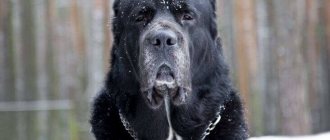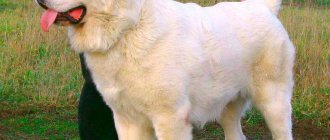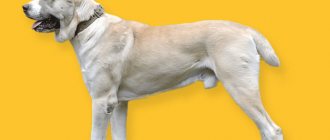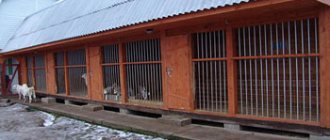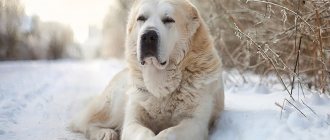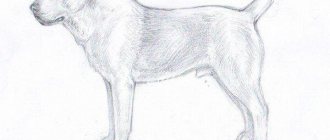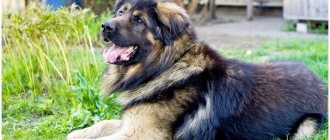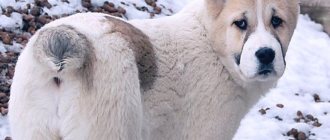- Height at withers: Males 70 - 95 cm; Females 65 – 78 cm
Weight: Males 60 -100 kg; Females 45 – 65 kg
Note: male dogs must have two full-fledged, well-developed testes, completely descended into the scrotum.
Disadvantages: small deviations from the standard requirements that do not violate the overall impression and do not affect the working qualities of the Alabai (Central Asian Shepherd Dog) are acceptable.
Alabai has a hard and straight coat, with a fairly thick undercoat. Thanks to its thick skin, it is protected from enemy bites.
Alabai character
The Central Asian Shepherd is similar in character to the Caucasian Shepherd.
Since for quite a long time the Alabais developed the ability to stand up for themselves well, aggression towards their own kind became entrenched at the genetic level.
Alabai will be ready to “tear apart” any foreign dog that comes into his field of vision, but he treats his brothers who are in the same yard with him quite calmly. Despite its well-developed security qualities, with proper training, it will never attack a person.
The main character traits of the Alabai are confidence, endurance and courage. It combines fighting skills and calmness, and is one of the most intelligent breeds in the world. Since the Central Asian Shepherd is characterized by its willfulness, it requires professional training at an early age and socialization. The reaction to stimuli in a Central Asian is quite long, and in order to distract him, it is necessary either to eliminate the provoking factor or to attract attention with another stimulus.
If you are looking for an unpretentious and reliable friend, a guard for your property, she will be just perfect. Alabai combines character traits similar to the Great Dane and mountain herding shepherd dogs. They are independent and proud, self-confident, distrustful of strangers, and at the same time they very subtly sense fluctuations in the owner’s mood.
Varieties
Breeding Asians is inextricably linked with attempts to improve the qualities of the animal. The native species have been modified, and today there are intraspecific varieties, which allows unscrupulous breeders to claim the presence of characteristics that specifically distinguish the Asian Shepherd.
The Central Asian Shepherd Dog, also known as the Turkmen Dog, is the original species, which is divided into 2 types:
- Alabai is a familiar representative of the breed for city dwellers, distinguished by a relatively small head and a character suitable for living in a family;
- The Kalon leopard is a wayward dog that is difficult to train. Used as herding dogs on Asian cattle ranches.
Classification by territory allows us to distinguish 3 more varieties, but they are not recognized as breed representatives. These dogs are distinguished by their small numbers:
- Caucasian - bred by interbreeding with Caucasian Shepherd Dogs;
- Tibetan - a similar type obtained after crossing with Tibetan mastiffs;
- Turkish is the newest version of the breed, and the name raises many questions - there is no information about their breeding in Turkey.
Alabai (Central Asian Shepherd) care and maintenance
Alabai puppies play on the sand
Keeping and caring for the Central Asian Shepherd does not require much labor or effort. The wool is resistant to dirt and will look well-groomed and clean even in the absence of regular care.
Alabai sheds quite heavily in the spring, then continues to shed throughout the year, but not so intensely. With regular separation of dead fur, the amount of shedding in the house will be significantly reduced. It is recommended to brush the Central Asian Shepherd outside, in an open space.
It is important to inspect and clean your ears on time. It is recommended to trim the claws 2 times a month. Alabai is a large breed and is prone to joint diseases. Therefore, from puppyhood, make sure that she receives a properly balanced diet. The optimal condition for keeping a Central Asian Shepherd dog would be a private house with an aviary.
Alabai tolerates heat and cold quite easily and is not fussy about food. Alabai males are distinguished by their independence, but females have a calmer character. Therefore, it is recommended to keep individuals of different sexes in the same territory. They need good exercise and long walks.
The size of a dog compared to a person
A comparison of the size of the Central Asian Shepherd Dog next to a person can be shown by its height at the withers or when it stands on its hind legs.
Thus, the average height of adult Alabais at the withers is at least 70, and more often 80 cm, which indicates that the head of a pet of this size will be almost at the level of the knees of a person of average height.
Standing on their hind legs, these dogs can be the same height as their owner or even taller.
So, when the largest, in fact, even huge, Alabai in the territory of the former USSR, nicknamed Bulldozer , stood on its hind legs, its height was about 2 m, which exceeded the height of its owner.
Alabai food
In the photo Alabai mother with children
The Central Asian Shepherd requires a balanced diet with the required amount of vitamins and minerals.
The main rules for proper feeding of Alabai are as follows:
- The presence of two bowls (enamel or aluminum) - with clean water and for food;
- The bowls are placed on a special stand where the height is adjusted. He should reach up to eat food, and not lower his head down;
- Dry food or natural food is only high-quality and fresh, food at room temperature;
- Alabai should always and at any time have access to a bowl of water;
- Feed at the same time. If you haven’t finished eating, the bowl of food is removed; do not allow yourself to overeat;
- Do not give tubular bones or sweets.
Basic rules for proper nutrition in Alabai:
- Since pork fat is poorly absorbed, it is not recommended to give pork;
- The best meats to give Alabai are veal and beef. Give chicken with caution - watch for allergies and avoid the inclusion of tubular bones;
- You can replace part of the meat with offal, but do not exclude meat completely;
- Alabayas often cook soup - first the meat is boiled, then cereal is added to it and left to cook until half cooked. She should not eat more than two liters at a time;
- The diet includes sea fish;
- Cereals - rice, buckwheat and oatmeal;
- If there is a need to switch to a new food, then this must be done gradually, adding new food daily for 6-8 days;
- Fermented milk and dairy products, cottage cheese, and eggs must be included in the diet.
Choosing a puppy
Given the multiple intraspecific varieties, a number of sellers using the Internet as a marketplace offer a variety of puppies, claiming to be from different breeds. Beautiful and original terms are used, it is described how the Alabai differs from the Asian, but there is a high probability that behind the “beauties” there are puppies obtained from interbreed mating.
A breeder who is really involved in breeding Asians, when asked: what is the difference between the Central Asian Shepherd Dog and the Alabai, will immediately answer that these are different names for the same breed . Therefore, if you want to buy a purebred dog, you should contact nurseries where there are no difficult to pronounce and newfangled names.
Accordingly, the differences between the Alabai and the Central Asian Shepherd are only in the name and, when purchasing a puppy, you can “introduce” it as familiar in any way: the choice depends on the taste and preferences of the owner.
Training the Central Asian Shepherd
Alabai photo in the enclosure
You need to devote at least 20 minutes a day to training a Central Asian Shepherd. All family members take part in raising the alabai, observing the general rules. Despite the fact that the Alabai is a traditional workhorse, it needs proper training.
Already by the age of 9 months, take care of education and knowledge of commands, so training begins at 3 months of age. For an Asian, the most suitable is imitation training, imitation, as well as the operational method (motivational training). Great importance is given to the formation of a number of needs in him - positive emotions, the need for play, social needs (the need to communicate with animals, family members and the owner).
When training the Alabai, it is important to remember that he is vindictive and touchy. Applying harsh measures to them is simply inappropriate. It is not recommended to constantly suppress and scold your pet, otherwise this will lead to loss of contact with it.
In the photo there is an alabai for protecting a private house
The most important thing in training an Alabai is to develop obedience and compliance with commands. Just don't achieve this by beating.
The most important thing is that she should calmly give away the food. Teaching the “sit” command is quite simple. But with the commands “stand” and “lie down” the situation is more complicated. It is mandatory to follow the commands “come to me” and “nearby”. Having given an Asian a command, it is necessary to ensure its execution. It is important to teach him not to react to extraneous stimuli; to do this, walk him in different places, changing the walking route each time.
A separate and important point in Alabai training is control over aggressive behavior towards other animals.
It is extremely important to socialize your puppy to other breeds at an early age. Do not forbid communicating with your own kind. If manifestations of unreasonable aggression towards other pets are noticed, it is necessary to strictly punish them. Proper upbringing and care of an Asian will make him a wonderful friend and reliable guard.
Education and training
Owners of Central Asian Shepherds must clearly understand that training and proper education for such a strong animal, which also exhibits pronounced defensive reactions, are necessary by definition.
It should be remembered that Alabai is quite capricious and is unlikely to immediately obey you. You can achieve results only by showing a fair amount of patience and finding ways to interest your Asian in the learning process.
As for gender differences in relation to the training process, males learn much easier. Girls are much more subtle and cunning; they have much more tricks in their arsenal to avoid obeying the “teacher.”
Photo of Alabai or Central Asian Shepherd Dog
Historical reference
Central Asian Shepherds belong to the Molosser group. Ancient Egyptian and Assyrian dogs are considered their ancestors. Among the ancestors of the breed were Mongolian shepherd dogs and Tibetan mastiffs.
Alabai was finally formed about four thousand years ago. Selection was carried out naturally. Dogs guarded caravans of nomads and herds of shepherds. By protecting property from steppe wolves, the strongest individuals survived.
Wolfhounds were distributed throughout Central Asia. From Afghanistan to the Southern Urals. From the Caspian Sea to China.
Turkmen wolfhounds of pure blood are the national treasure of Turkmenistan; they are prohibited from being exported outside the country.
In the 18th century, biologists became interested in Turkmen shepherd dogs. Scientists tried to breed a more docile version by crossing. The attempts were in vain.
Photos and descriptions of colors
The Alabai coat can be not only white or black and white, there are many possible variations of its color.
White
There are no albinos among the Alabais, even in the absence of a coloring pigment in the coat of these dogs, which is why it looks snow-white; the lips, nose and eyelids of the Alabais are colored black or brown.
Ginger
Red fur can have many shades: yellow-golden, fawn, light beige, reddish-red and copper-brown. The coat may be solid red or have white markings on the chest, belly, paws and face.
Dogs with a color called wolf look especially attractive: the main color of their coat is bright red or has a gray-brown tint, the hairs on the stomach, neck and chest are white, and the lower part of the forehead, cheeks and area around the eyes are black or dark -gray.
Black
The coat can be solid black or have dark brown, white or red spots.
The most common coat color of Alabais is a combination of black and white. If the main color of the coat is white, then black spots are located on the back, hind legs and top of the dogs head. In the case when the fur is black, the belly, chest and lower part of the paws of the Alabai are painted white.
brindle
The tiger alabai is the owner of wool, the color of which is combined with gray, brown or yellowish-golden colors. On the back, neck, croup and limbs there are dark stripes located transversely and closing into rings on the chest and belly.
Many individuals with this color have almost black fur on their faces, making it appear as if they are wearing masks.
Brown
Brown coat color varies from pure brown to brown.
NOTE!
In accordance with the standard, silver-blue and chocolate coat colors are considered unacceptable - it is believed that coat of such colors is characteristic of dogs that are a cross between an Alabai and a Great Dane or a German Shepherd.
Description of the breed
FCI Standard No. 335 dated October 13, 2010 “Central Asia Shepherd Dog”. Group 2 “Pinchers and Schnauzers, Molossians, Mountain and Swiss Cattle Dogs.” Section 2 “Molossians”.
The FCI standard specifies the dimensions of an adult Alabai: Height at the withers: for a male, at least 70 cm, for a female, at least 65 cm. Larger height is desirable while maintaining harmony of build. Weight: minimum 50 kg for a male, minimum 40 kg for a female.
Central Asian Shepherd: The breed description includes a powerful body, broad chest and back. They are distinguished by a wide, massive head with a flat forehead, a voluminous muzzle with a large black or brown nose. The eyes are set wide and round. Small triangular ears, sometimes cropped - the standard allows both options.
The belly is slightly tucked in. The height at the withers is slightly higher than the height at the rump. The paws are compact and strong.
Tail docking is allowed by the standard; a natural tail has equal value to a docked one.
The coat is coarse, hard, straight, with a thick undercoat. Depending on the length of the guard hair, dogs are distinguished with short hair (3-5 cm), lying all over the body, and with longer hair (7-10 cm), intermediate type, forming a mane on the neck, feathering behind the ears, on the back sides limbs and tail.
The standard allows any color, except for genetic blue, genetic brown in any combination and black-backed.
How long does alabai live? Life expectancy with proper care is, on average, 12-15 years.
History of the name
The International Cynological Association calls the breed “Central Asian Shepherd Dog”. The remaining terms are synonyms. The word “alabai” itself has Turkic roots. This is what the Turkmens call the SAO, emphasizing the multi-colored color of the dog. “Ala” means “motley”, “bai” means rich.
Therefore, Buribasar, Tobet, Central Asian Shepherd Dog and Alabai are different names for a beautiful and powerful dog with a large head and massive body.
Characteristics, skills and abilities
During their existence, alabai were used mainly to guard livestock, caravans and the owner’s home, being subject to strict natural selection. Difficult living conditions and constant struggle with predators shaped the appearance and tempered the character of this dog, made it strong, fearless, and taught it to use energy sparingly.
In their original habitats, Central Asian Shepherds are used primarily to protect herds from predators, and also as guard dogs. They are characterized by an independent line of behavior; they will not serve because of food. Rather, with a sense of self-esteem, they will take food as a reward for service.
He will not look away when you look closely, but will proudly and calmly look down on you - this is the best characteristic of the Alabai breed. They prefer to think when making decisions and may refuse to carry out commands from their owner that they consider inappropriate.
Alabais are phlegmatic and balanced. They don’t like to show aggression or rush into battle. They will most likely warn you by barking or growling that you should not violate their boundaries. Alabai: characteristics of the breed, reviews indicate that only in rare cases do they turn into ferocious fighters.
Alabai really dislikes drunks and invasion of his personal space.
Asians treat children well, but do not allow free treatment. They communicate very well with their fellow tribesmen, flock together and recognize their place there.
Training. The characteristics of the breed do not allow inexperienced dog breeders to raise and train. Raising an Alabai at home should begin almost from birth under the guidance of a dog handler. By three months, wolfhounds have developed an independent personality and it will be much more difficult to correct an established pattern of behavior.
It is forbidden to cause pain to the alabai. Screams and too sudden movements should be avoided. The dog can get out of control and injure itself.
The Asian should be taught to give food to the owner. This is how the puppy learns who is the leader of the pack. You can’t indulge your pets - they quickly take the reins of power into their paws.
Quite quickly, shepherd dogs begin to follow standard commands. Nevertheless, raising a dog should be entrusted to a training specialist.
Regional varieties of dogs, photos
Although there are uniform qualities and characteristics that are true for all representatives of the breed, each subspecies has its own characteristics .
Turkmen
Strong, balanced and independent. It has the best qualities of a guard dog. Not a fighting dog, but able to protect itself and its owner. Strives for leadership, both among animals and among people.
It is recommended to start only strong-willed people who are confident in their abilities. May be dangerous for children and weak-willed people. Submits to the owner, but may not carry out the orders of younger family members , especially if the person is confused or doubts. Very curious.
They explore everything around and try to taste it. It is important to wean your dog away from such behavior in early childhood, otherwise later it will pose a serious threat to the pet’s health.
Caucasian
A formidable guard and fearless fighter. More aggressive than its Turkmen counterpart. He values his freedom very much; it is difficult to achieve his submission. But if you succeed, you will receive a devoted defender, capable of predicting the enemy’s tactics and rushing into battle against a stronger enemy. The Caucasian Alabai obeys only one owner , so difficulties may arise when keeping it in a family. Especially if there are children in the house. Most often, this species is kept for protection.
These dogs do not require special care and are not fussy about their living conditions. But they need a place for physical activity and constant exercise. Therefore, they are better suited for private properties than for a city apartment.
The size of the Caucasian alabai is slightly smaller than the Turkmen alabai . Average height 65-75cm, average weight 50-75kg. But they are not inferior to him in strength, and superior to him in speed and intelligence. Caucasians live about 14-15 years.
Tibetan
Impressive dogs with well-developed muscles. Tall and strong. Average weight 60kg, height 60-67cm. Small subgroup. The main difference is a calm disposition. It is still an excellent watchdog and guard, but the Tibetan variety is neutral towards other animals. The level of aggression in the character is much less.
These even-tempered animals love to spend some time alone. They can become good friends for children, but it is not recommended to leave them alone.
Turkish
Turkish alabai is also called kangal. One of the best assistants to shepherds, easily managing large flocks. This subspecies is much more peaceful than its counterparts. Loyal not only to the owner, but also to his “pack”, represented by the family. Obedient, but at the same time can think and make decisions independently.
The color is fawn with a gray-brown, gray-yellow or yellow-brown tint. The breed is not represented in white. There is a black “mask” on the muzzle. These dogs need space, fresh air and constant exercise. They are not suitable for keeping in an apartment.
Owner reviews
The owners of Central Asian Shepherds are unanimous in their opinions about the breed. There are the same pros and cons.
Yaroslav, Chelyabinsk. “I am the owner of an adequate representative of this breed with an excellent pedigree. Mukhtar is a faithful friend. A good watchman. Allows children to hang on themselves. I recommend it to those who live in rural areas. Disadvantage: I tend to make independent decisions.”
Eris, Korolev. “The best dog of my life! Big defender. I wasn't afraid to go anywhere with her. A very faithful friend. Rona was level-headed, but had her own opinions. She lived with us for 17 years. It’s been three years since she’s been with us, but I still can’t get a new dog. The Alabaika was too good.”
Slavyana, Khmelnitsky. “A dog is a friend, a guard dog. Alabai is a naturally bred shepherd dog breed. They have high intelligence and endurance. Unpretentious. There are practically no complaints. The only negative is that she is wayward.”
Possible variations
We found out that the Alabai differs from the Asian only in name, but beginners also have to face other difficulties. Let's figure out the difference between the Alabai dogs offered by breeders, and how to avoid being scammed when buying a pet.
Tibetan
The breed is represented by crossbreeds of Asians and Tibetan mastiffs. There is no official standard.
The dog, called the Turkish Alabai (pictured), differs from the Central Asian Shepherd as the result of an unclear crossbreeding
Turkish
A mysterious option from unscrupulous sellers. Even the Turks themselves have no idea about such an animal.
Caucasian
Another mestizo obtained by crossing with Caucasian Shepherd Dogs. Received no recognition.
The Caucasian Alabai's resemblance to the Central Asian Shepherd Dog gives it a touching appearance
Turkmen
The only official version of Central Asian Shepherd Dogs, including 2 varieties:
- alabai - classic Asians, with the most attractive exterior and good disposition (they are used not only as guards, but also as faithful companions);
- Coplon leopards are an indigenous variant, characterized by aggression and used to guard livestock.
Coplon leopards are the same alabai, but not for home

